
I’ve always loved these early downsized Caprices. I’ve probably mentioned it before, but when I was a little kid there were TWO 1977 Caprice Estates on my block. They looked so cool. One cream, one tobacco brown. Both with Di Noc woodgrain sides.
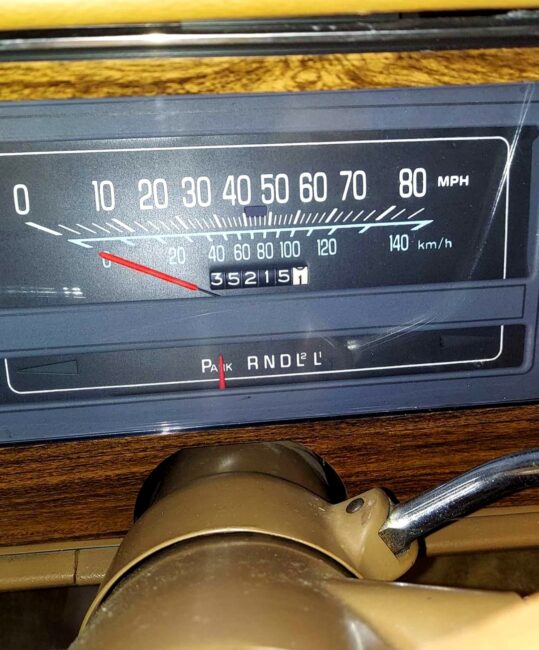
So you can imagine my Brougham Radar going awooga when I saw this the other day.
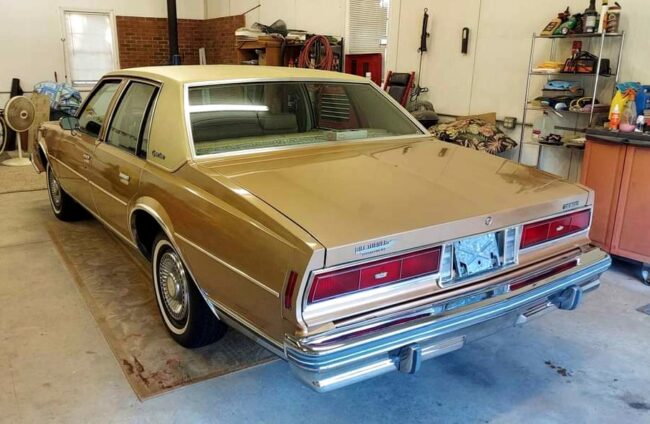
Per the ad: “This car is a 1977 Chevrolet Caprice Classic. This is a 1 owner car with all the original papers. 35,200 original miles.”
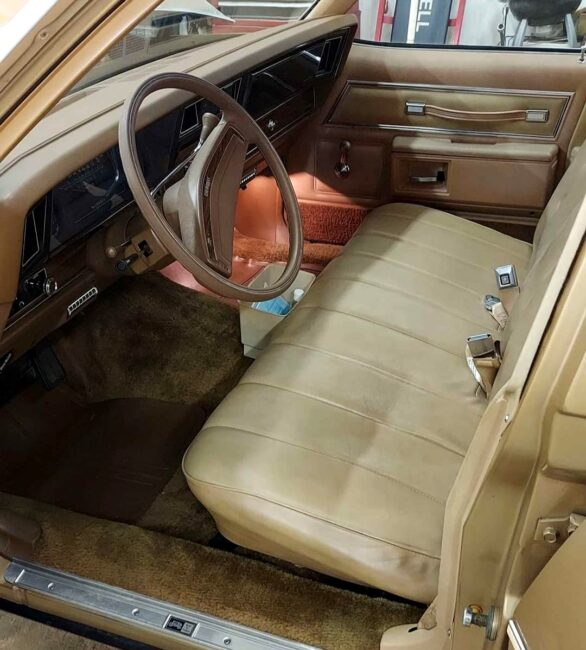
“Original paint and vinyl top. Perfect tires. This is a North Carolina car with no rust. Tilt wheel cruise control and air conditioning.”
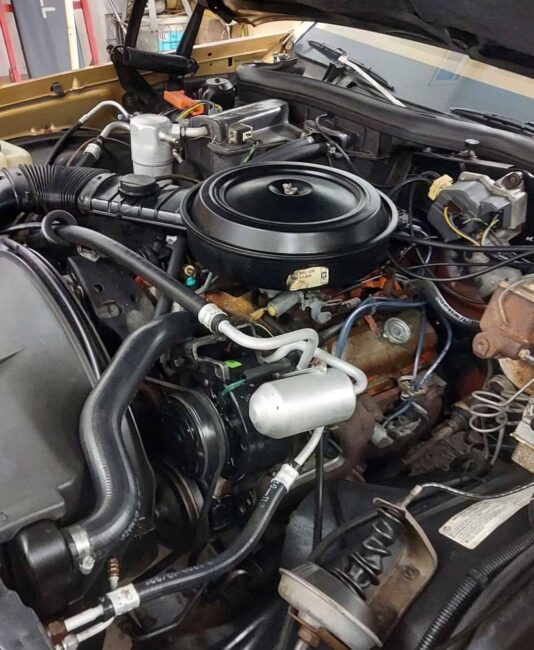
“The engine is a 305V8. Garage kept always. This car is in perfect shape. No tire kickers please. For more information Call 706 884 1870 Or 706 298 9848.”
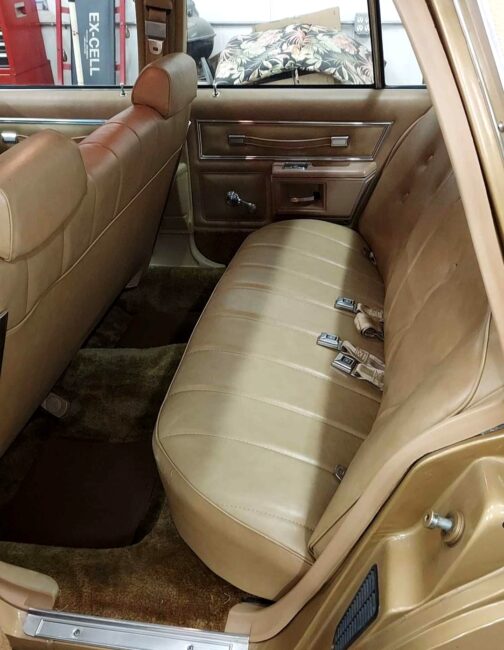
Now it looks great. I love the gold. It’s a shame it doesn’t have the 350 V8 and THM transmission.
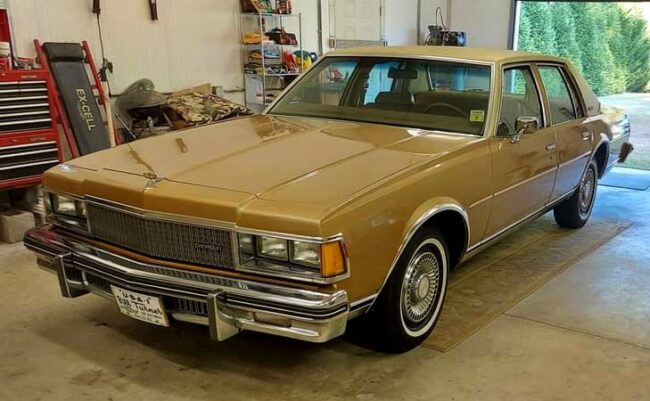
And you bet it’s pricey, at almost nineteen grand, though clearly a time capsule.
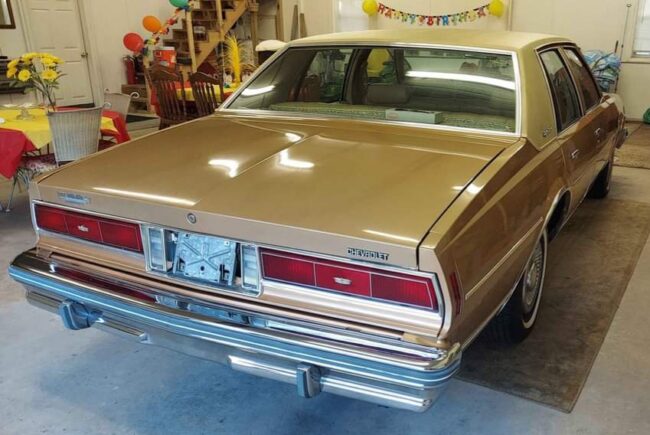
I remember a neighbor back when I was a teen, Jim Carlson, bought a light beige ’77 Caprice Classic as a work car.
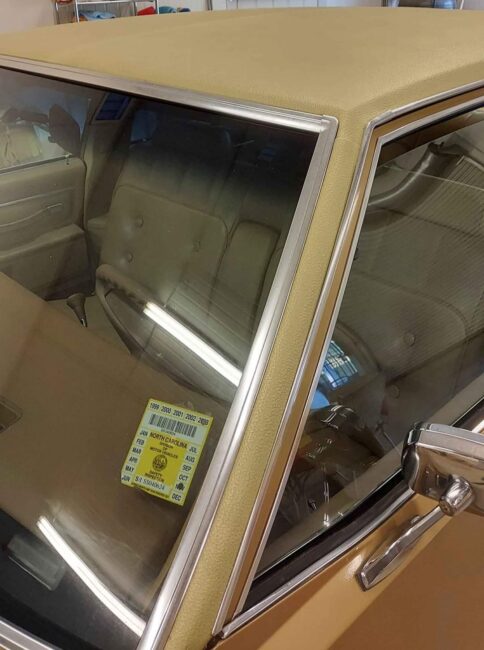
It wasn’t mint but it was nice. Matching beige top and velour interior, a sedan.
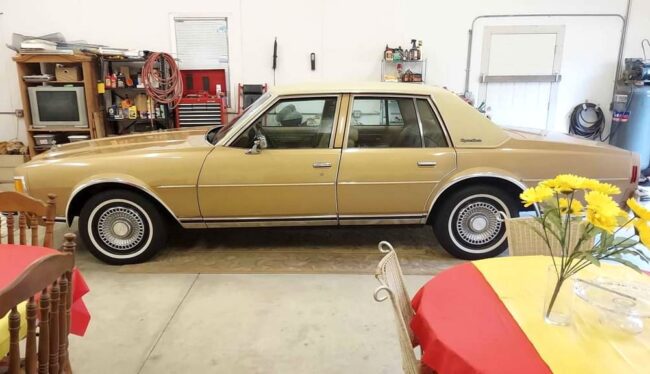
He worked at the Rock Island Arsenal and frequently bought older ’70s cars as work cars; his wife had a nice late model Town and Country.
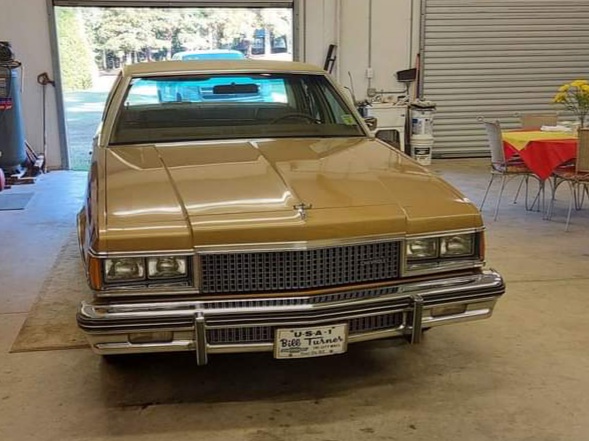
This was circa 1998-99 and you could still find these in nice shape for cheap. Those days are long gone.
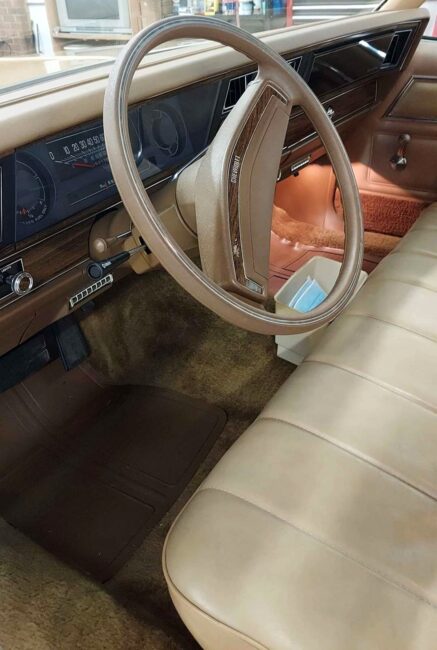
I don’t think I’d pay the ask on this one without a 350, but it shows a time when people still appreciated a large, attractive sedan, and didn’t settle for a silver silvermist Equinox because they were scared of their wife. Bwa ha!
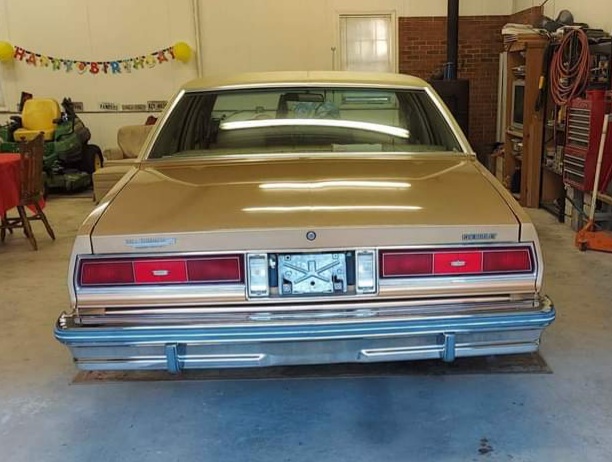







88 Comments
Interesting. I thought the Caprice came standard with the split bench in those years. The seat almost looks Impala-ish.
Nice piece. I wonder if they’d take $14,500 for it. (Not that I’m looking—if I ever got serious about owning a classic like this, my first order of business would be to have a single-stall storage unit that wouldn’t break the bank for monthly rent.)
These downsizes are a challenge for me. Giving up size and weight brings to mind austerity. As today, the period had high inflation and America seemed in decline. Whether you were a buyer trading in a 7 year old Impala or a younger buyer in his first new standard car experience, you were literally paying more and getting less. Given that you were dealing with people who had followed the rules and done the right things, at a time when many no longer bothered. The outcome seems heart breaking.
you were literally paying more and getting less
It depends what you are talking about. Yes, you got less weight but I don’t know how many people use lbs per dollar as a criteria for deciding which car to buy.
You also got more interior space, you got more trunk space, you got more miles to the gallon, and the new B bodies handled a lot better than the cars they replaced while still giving a traditionally smooth ride as expected from a large American sedan. There was a lot on the line so those cars, unlinke the execrable X-cars that followed, were well engineered and fettled. I also happen to think that they were a great aesthetic improvement over the full size Chevys of the mid ’70s.
Why do you have a hard time acknowledging that they were better cars than the ones they replaced?
I think John really bought into all those Ford commercials in 1977 where they bragged that their cars had not been downsized and hence had more “road hugging” weight than these GM lightweights. Of course the real story was Ford had been caught flat footed and was trying to make lemonade from the lemons they had to sell. It is worth noting that the lower weight was achieved not just through smaller size, but also because these cars were the first to be designed with CAD software and to extensively feature new high strength steel alloys that allowed a much stiffer and yet lighter body/frame structure than the full-sizers they replaced. In other words, quality replaced quantity.
Ronnie I understand why your side of your generation accepts the editorial position that these downsizes were good pre 1980. It was where your generation started to have an influence not so much as buyers but as designers and in the dictates to which the new design must follow. The influence took away the mindset clearly still present on the 1971s of wait till the people get to check out what we did this time, to a mindset of how much can we minimize the damage being done by the new rules on the 1977s.
Why you hate the X car is not the bogus trial lawyer stuff like brake proportion valves, but the more revolutionary flipping the script in changing everything about the car in order that the customer can be given just what they had before in the Nova. Movement front man Ralph Nader be dammed. Not what your side wanted because they were really going to enjoy watching the Nova shrivel up and die on the vine as was happening with the Impala.
A big problem with American car companies is that they discovered the most profitable way to build prestige car was to simply make them bigger versions of cheaper cars. Rather than invest in independent rear suspensions or Citroen style hydraulic suspension systems to provide a good ride with a smaller car, it was much cheaper to simply lengthen the wheelbase and add weight to a rather primitive body on frame car to offer a “magic carpet” ride. Similarly, a few inches of extra sheet metal and some extra chrome and fake wood was a far cheaper way to separate a Cadillac from a Chevy rather than invest in a V-12 motor, 4-8 speed automatics, fuel injection, OHC, 4 wheel discs and ABS, and real wood/stainless trim that would have given the Caddy some real technical advantages to justify the price difference.
When higher fuel prices and CAFE made larger sized dinosaurs unattractive in the 1970s, Detroit didn’t know what to do which is why by the mid-80s you had strange situations such as Cadillac DeVilles with smaller bodies and motors than cheaper Chevy Caprices. Given that BMWs, MBs, and Volvos were also smaller than Caprices, this might have been pulled off, but unfortunately the down-sized Detroit luxury products tended to have smaller bodies were either ugly and/or looked like cheaper brands (i.e. Chrysler K-cars looked like Plymouth K-cars, FWD Caddies looked like Celebrities and Cavaliers) and utilized drivetrains and chassis that did not employ any cutting edge technology and hence weren’t more powerful or fuel efficient or better riding than the cheaper brands in the lineup. Throw in some quality glitches (i.e. V-864, HT4100, Olds Diesels, Northstar head bolts) and poor build quality and you would have to be a totally blind and brand loyal 70 year old to justify buying a new Caddy or Lincoln or Chrysler versus cheaper equivalents in the corporate family lineups – or better yet buy Japanese, German, or Swedish.
If the bigger is better situation is some sort of American disease that should be stomped upon, could you explain why at BMW the 7 series is not at the bottom of the line with the 3 series at the top?
Bigger is better is true for humans and most other animal species – probably because size equates with better survival chances and mating success. Thus taller candidates usually win elections, and bigger stuff (within reason) is more popular and profitable. The difference between Cadillac and Chevy and a 7 and 3 series is that a 7 provides not only larger size, but also more technology and features as standard or optional extras than a 3 series. Thus you can get a V-12 or V-8, air-ride, 57 way adjustable seats with massage, rear-seat fridge and entertainment, and 57 choices of leather/wood/carbon trim and patterns for the far more spacious interior of a 7 that are not available on the 3. In comparison, Cadillac during the mediocre years offered very little that wasn’t also available on the Chevy, and the extra length became a hindrance rather than advantage by the late-50s, particularly when it provided little extra space.
Just to be contrarian, I’d suggest that part of the American luxury car problem was that the cheap cars were so good. If you look at the 1.3-liter penalty boxes being driven by the European family man in 1975, none of which had any technology as such and all of which were cramped, slow, and unpleasant to sit in, a 1975 Impala or Chevelle was already a 5-series or better.
A 5-series in 1978 was primarily distinguished from the 3 by having a larger rear seat. A 7-Series had an on board computer, power windows as standard, and the Big Six. Their engineering and materials were basically identical across the line. When I was learning to drive, my father had a 733i and his wife had a 325e. Size was all that separated them.
That is not where I thought you would go Stingray. I thought you would say that the 3 series is the real star of the BMW line and the 7 series only exists because some Germans have a GM or BL style resentment toward Mercedes with their gothic style and industrial heartland construction location.
Not to dispute your personal experience Jack, but my father had a e12 530i and 2002, and I owned a 2002, e21 320i, e30 318is and there was more than a backseat’s worth of difference. The big six was only available on the 5, 6, and 7 and it was a whole lot more refined than the spunky 4 in the 02/320i, and the 5+ models also had far superior seats (equal or better than Volvo in my opinion) while the 02/3 were clearly built to a lower price and not available in leather. Things perhaps got a little more blurred during the mid-80s when you could get a 6 cylinder and leather sport seats on a e30 3 series as exchange rate swings and tougher Japanese competition forced a move upmarket for the 3 series, but by the early 90s the gap was restored as 5+ series could be had with V-8, V-12, and moved up in size and feature count.
Your assessment of the basic goodness of the full-size low-priced 3 in the US is highly accurate. You got a heck of a lot of car for the money with a Chevy Impala/Caprice or Ford LTD (although Plymouth was fading badly by the early 70s), with drivetrain and luxury options that were pretty much on par with Cadillac, Buick, Lincoln, Chrysler. Yet the fact that they made great cheap cars, and pretty technologically advanced cars in Europe (the 70s era European Granada was superior to any Volvo and low end Mercedes, and Opel Commodore was just a notch behind) means they were capable of doing a lot better with the ir upscale US offerings.
To paraphrase a comment made about BMW and Mercedes sedans in the ’80s, what length sausage do you need? I remember a Mercedes-Benz advertisement of the period that pointed out that everything from a 240D to a 380SEL had the same technology in terms of brakes, suspension, wheels and tires, door latches, recirculating ball steering, and safety cages. They might have mentioned engine architecture and transmissions too.
People my age were still in college when the downsized B bodies were being developed, hardly in positions of influence at the car companies.
I had nothing against the Nova and as a matter of fact, a 9C1 Nova (aka four door Z-28) takes a spot in my dream garage. As it happens, most of the X cars were better equipped than most Novas would have been as there were plenty of stripper Novas.
My dislike for the X cars stems from a Pontiac Phoenix which was, in terms of quality control, the second worse car that I ever drove for any extended period, the only worse one being an Austin America.
Look, starting with the Clean Air Act of 1968, American automakers had to keep up with an accelerating treadmill of regulations that resulted in add-on battering ram 5 mph bumpers and engines that almost ran better after you shut them off (dieseling was a common phenomenon). By the mid 1970s, American cars were bloated and ran poorly. The downsized B bodies were the first clean sheet effort to deal with those regulations and GM did a great job on them. That’s one reason why the X cars were so disappointing.
Then after the X car fiasco, the suits at GM decided to scrap the individual car divisions, which had worked pretty well for most of the 20th century, and replace them with large and small car groups.
There has always been a lot of talent at GM, it just hasn’t always been managed well.
Gosh, we disagree on so much Ronnie. I even like Austin Americas and the Pontiac Phoenix, well at least the fwd 2 door with that nice mini Grand Prix dash and the velour bucket and console interior.
I disagree also that your generation did have a great deal of influence on the 77s. This needn’t have been as destructive as it was. We forget that for every long haired pinko fag with a commie flag in his garage that Charlie Daniels sang about in Uneasy Rider there was also a swift boat veteran for truth. Who to listen to, would have been an easy choice for me.
https://youtu.be/752o2cyZkTQ
I love these.
My first car was a light brown 1984 caprice landau coupe. It was wonderful. Slow 305, but magnificent induction noise, and a relatively throaty exhaust note after my mechanic punched out the cat.
I keep threatening to sell my wrx and buy one of these… maybe LS swap it… do a kinda restomod thing.
These really are classy cars. Thanks for sharing!
We have really become spoiled with modern motors. This 305 Caprice would be lucky to do the 0-60 run in less than 13 seconds, which makes it considerably slower than a Prius that will easily get more than double the 20 mpg you would be lucky to squeeze out of one of these if you stuck close to the double-nickle speeds it was designed for. The problem is this one is so nice and original it would be a shame (and expensive) to pay almost $20K and then resto-rod it with a modern crate motor, but on the other hand how many people want a relatively large and somewhat boring looking sedan that is slower than a boring Prius?
Does the owner of a 3000lb 65hp 240D ask themselves the same question?
How many people want a smallish mid-size sedan that smells like an old barn inside thats slower than a badly running loaded garbage truck and sounds like one too?
You have a good point, and I’ve never understood the appeal of the 240D other than it can run on old french fry oil.
They have a charm….I kinda like the older stacked head light 68-75 versions that still had a pull to start knob for the diesel. If you like your stuff german….its very german.
My uncle had a 75 240D and I thought it was miserable, noisy, slow, rock hard seats, and it didn’t do much better on the mpg than my dad’s 530i with almost triple the power. Not everything German is fit for export.
I like how those old mercedes sedans look when they’re on air and low enough to scrape asphalt. But I also must have gotten dropped on my head as a kid cause I like just about anything on bags even though it’s expensive and impractical
Think of what going all diesel in the USA meant for their 2.8 DOHC six. Pretty explicit no that they were themselves off-track sticking religiously to under 3 liters?
I’ve always kinda liked the circa 71-76 240D too, simply because I had a Corgi Toys version as a kid. Silver, tan interior with opening doors and trunk.
But I’d much rather have a similar vintage 280SEL, the one before the W116.
That’s a weird Caprice. I suppose this wasn’t a Caprice Classic, but that interior looks more austere than the one in my friend’s Impala wagon. The carpet might be nicer, and clearly this one was always garaged, but the seats look like they belong in a two-hundred-thousand-mile taxicab. And hand crank windows in a Caprice? I remember Caprice Classics having an almost bristly cloth seat upholstery, power windows and locks, and a distinctive chemical and electrical-short smell when delivered that popped into my head while I thought about the seats being so wrong.
I’m not sure why anyone would be nostalgic from a car built for an era when the progressives were succeeding in their effort to run the country into the ground, particularly when they’re currently trying to finish the job. That 80 mile per hour speedometer brings it all back for me. Pure misanthropy.
I guess you could be nostalgic for an era when GM could still design a completely new line of cars that were class leading and not cost cut into having lots of quality lapses and reliability and durability problems that plagued most future GM new models.
It is interesting to look at the progressive agenda back then: feminism, civil rights, and appeasing Communists/adopting socialism, and solving the environmental problem were all leading issues of the time. Now women can do anything they want and are more miserable and whiny than ever about supposed glass ceilings. Blacks can also do anything they want, but race relations are arguably worse then ever after a black president was elected to two terms by “racist” whites and police now get jailed for arresting criminals of color. Civil rights has now moved on to helping mentally ill men beat up women in sports and on Jeopardy. Communism collapsed, but socialism is hotter than ever and still failing where ever it is implemented. And instead of worrying about running out of oil and global cooling, progressives are now trying to keep record oil reserves in the ground to fight global warming. In other words the entire progressive agenda has been a complete failure, but at least you can now bury the 80 mph speedo on this Caprice in Texas without getting a speeding ticket.
“I guess you could be nostalgic for an era when GM could still design a completely new line of cars that were class leading and not cost cut into having lots of quality lapses and reliability and durability problems that plagued most future GM new models.”
Didn’t these cars work because they were just rebodied intermediates that had been in production since 1973?
If only we could edit out those hideous old white guy designers and bring in some new Asian friends to copy the Germans than finally things would work. Gee what genius.
John – how do you explain the fact that German white guys continue to design innovative and desirable vehicles and maintain strong brand equity, while American white guys who designed the best cars in the world from about 1908 to 1970 all of a sudden got stupid and lazy?
Germany protected their market pre 1990 and so their own rot set in later. A big advantage helped also by how long the 1968ers were allowed to stay in school and thus out of the way. The USA just let all the middle fingers fly at there own white guys and did nada to stand together against the onslaught.
Germany did not protect their market anymore than other European countries (and less than most). What protected the German market was generally superior vehicles that held up to autobahn speeds, which is why German cars became dominant in much of the rest of Europe and even made inroads in very protected markets such as Japan (and more recently China). You also need to consider the outcome of Germany vs. Japan when upscale Lexus, Acura, and Infiniti were introduced and initially took a lot of share from the Germans in the US market (although they never made big inroads in Europe). Within 10 years all but Lexus were bit players and MB and BMW are the top selling luxury car brands in the US and the world by far. In other words, the Germans upped their game to compete, and Lincoln and Cadillac made Navigators and Escalade versions of Ford and Chevy SUVs.
CJ – yes the chassis of these downsized full-sizers was a lightly reworked version of the 1973 intermediates, but the body structure was all new and much improved in all respects.
This is a Caprice Classic, you can see the emblem on the C-pillar.
Its a fairly basic Caprice Classic, cloth, power windows, etc, all that was optional. You could even add automatic climate control and a sunroof too.
I have questions about the condition of this car overall, you would think that a 35,000 mile car would still have some GM “corporate blue” paint on the engine block and no suspicious looking black spray paint over-spray in the engine compartment……
I wonder what this car had that an Impala didn’t. A friend had a 1979 Impala Wagon, and the vinyl top is the only addition I can recall. I get it that everything was optional when Detroit had its way. Another friend’s father bought a Suburban with two window strckers from the factory. The options didn’t all fit on the first one. Did buying a Caprice Classic just get you privilege of being able to buy more options?
Paying for the fancy brand as a means of attaining the privilege of gouging yourself with further expensive options is what keeps the lights on at the Porsche, Ferrari, and Rolls Royce factories.
Front seat armrest, carpeted lower door panels, nicer upper door panel trim, color keyed seatbelts, full wheel covers, the nicer steering wheel with the wood insert, carpeted truck, the Caprice specific front facia with the stand up hood ornament and the rear “6 tail light” treatment that had been a Chevy high end full size car trait going back to the 58 Impala…..and probably a clock too.
I thought the armrest was extra cost, this one doesn’t appear to have it, I knew somebody that had a ’79 with the vinyl upholstery (which I believe was extra cost) and no armrest. I think the color-keyed seatbelts were optional, as well.
I think you could get most of the Caprice options on the Impala, too. My grandparents had a lightly-optioned ’78 Impala in this same shade of beige that I would take over this car because it had cloth seats.
Do you still have the ’80 with the astroroof that you wrote up for the sneaky little shit from Faber, er uh Eugene? Now that was a real unicorn.
I couldn’t tell from the angle if it did have a front armrest or not, the Impala also didn’t have the wood grain on the dash around the radio and hvac control, that was interior colored on the Impala.
You could get everything on an Impala as you could a Caprice, except for the Caprice specific body items like the front and rear ends.
Yes I do still have it, its a 1980, steel sunroof, F41 loaded with every option Caprice Classic, I just got it out this weekend after it being down for a while needed a brake rehab that I had been putting off, new master, calipers, shoes, wheels cylinders and lines and DOT 5and she’s back on the road.
My mother had the most expensive Plymouth Horizon sold during the 1979 model year, although I have no proof to offer. My parents ordered it about when they stopped taking orders on 1978s. Inflation was such that it cost more than considerably more substantial new Chrysler products they’d purchased during the ’60s and ’70s, but I guess people were taking that for granted at the time. Your comment about the Caprice reminded me of the carpeted lower door panels. She had a Horizon with carpeted lower door panels, chrome turn signal indicators visible for the driver on top of the front fenders, plastic wood on the dash and trimming the perimeters of piano-black filets along the door tops, velour reclining seats with adjustable headrests and brushed aluminum branding irons embedded in the pleats, A/C, rear defrost, rear wiper/washer(eventually used as a cocktail server when I was in high school), automatic transmission, whitewall tires, chrome fender opening trim, lower side moldings, a roof rack, an AM radio, completely carpeted interior and trunk, cargo cover, and I’m probably still forgetting a bunch of options. We had the brochure with all the options, and there was a plethora that my parents had resisted based on their frugality. Things like AM/FM/8-track/CB radios. The high beltline molding that filled in a body crease. Two tone paint, as seen on the 1978 release models. Fancier wheel trim. Aluminum road wheels. Moon roof. Power steering, based on CR’s denigration of the Omnirizon’s power steering system. In light of these important omissions, you might wonder why I said my Mom had the most expensive Horizon. It’s because I never saw another with anything like as high an option load.
Many years into the car’s run, Chrysler had the ‘America’ package, which was really the Accord package. It made things people bought standard so production complexity was eliminated, and they could sell the car for less while making more. Long before that happened, my parents paid a price that would have bought a great import, had they not been loyal Detroit customers. On the positive side, I did have one really cute girl make a big production out of how turned on she was by the plush interior of my hand-me-down Horizon. About two weeks after I got my license, and immediately following my parents having to replace the Horizon’s suspension after I landed a jump that should have been caught on film, my parents took the Horizon away and gave it to my sister. I then received the ultimate hand-me-down-car, which was a Scamp that had been through every other member of my nuclear family’s hands before I spent a year getting places but not getting back.
They were all Caprice Classics in ’77. And I believe through ’85. In ’86 they killed the Impala-in name anyway. What was the ’85 Impala became the ’86 “Caprice.” With the cheap Impala interior, no rocker trim, etc. The “Caprice Classic” was one step up, then the Caprice Brougham, and starting in ’87, the Caprice Brougham LS, which added the Chrysler Fifth Avenue-style padded landau roof.
I remember when these came out in the fall of 1976. I thought they were a real home run in terms of styling but for one big let down, which is the ugly wheel covers. 45 years later there are several elements that now look a little off to modern eyes such as the short wheelbase to long overall length ratio, the hopelessly clunky bumpers, and stupid vinyl roof, but the wheel covers remain the single ugliest feature. Why didn’t Chevy put their nice Rally Wheels on these instead of those ugly wheel covers (or at least make them an option)?
You now have had more time to think of why your 1977 respect was short lived. Maybe you were played by the other side.
In 1977 I was still a GM fan, although even at that time I looked back to their models of the 1950s and 60s with more enthusiasm than I did to the big bumpered and smog choked motor models of the 1970s. If GM has launched the X-body, J-Body, and updated their full-sizers with the same quality and attention to detail that they had put into the 1977 downsizing they would likely still be the biggest car producer in the world and I would still be a fan. As for the “other-side” what is that? Is that the side that has some enthusiasm for cars and believes that making better vehicles is the secret to success rather than the constant cost-cutting that Detroit adopted as the operating mantra?
You say those kind things about the 77s but looking at Tom’s example with a paint job that no German would ever do and a woodgrain dash and vinyl bench Germans wouldn’t even impose on their taxis must give you pause that you were indeed played.
I don’t get upset that a Chevy has less than perfect paint and fake wood on the dash when it was offered at a fraction of the price of the Germans, and with a better A/C system, automatic gearbox, and cruise control. The problem for GM is that their Buicks and Cadillacs were no better than the Chevy and hence failed to justify their higher price and supposed prestige. By the late 80s the Germans and Japanese were also offering superior V-8s (and even V-12s), multi-zone A/C, better automatics and cruise control systems, as well as ABS/stability control, and far superior build quality to what Detroit was offering even with their supposed upscale brands and models. In fact, during the 90s BMW was using GM Europe 5-speed automatics in their cars, which GM for some reason did not use on any of their US offerings.
There were a couple of wheel cover options, these were the most commonly seen ones, there was also a cross laced wheel cover that did a really good impersonation of an actually alloy wheel and the wire wheel covers or course.
The later Monte Carlo/Malibu/Camaro 5 spoke rally wheels would also fit on these, but the Chevrolet B-body never got an actual rim until the Impala SS.
Yea I remember the cross-laced cover, which was the best looking option but seemingly rarely ordered. I find it hard to believe that the various styled steel wheels used by GM at the time, including the Chevy Rally were more expensive to make than a regular steel wheel and a stamped steel wheel cover, which were seldom if ever as good looking. I always wondered if Chevy was prevented from offering a sporty steel wheel or alloy wheel on the Caprice to keep it from competing too closely with the Pontiac Bonneville.
I think they thought there wasn’t much demand for a rally wheel on the big car, which is kinda true, most of the times you see a wheel option on an old car today, it was added during restoration. For a few years Chevrolet actually covered its own rally wheels with a wheel cover on full size disc brake cars and 1968-1973 Corvettes with the optional wheel covers. By the time these cars came out the 1967-1968 ever popular “chebby rally wheel” was only available in the 8 inch version and they were out of production by 1982.
Buick didn’t offer road wheels on the Electra until 1970 or so even though they were available on the LeSabre, Wildcat and Riviera along with the intermediate cars from 1964 on. Oldsmobile 98’s didn’t offer any versions of the Super Stock I-IV series of wheels.
Of course the ones you see at cars and coffee shows today have far more options than they had when new, but I seem to remember seeing a fair number of full-size Chevies with the rally wheel option from about 68-70 and always thought they looked good.
I do have to make a correction here….the Oldsmobile 98 did have a wheel option between 77-79, it was a very rare chrome dished in wheel similar to what Ford offered on some full size cars pre-1979.
I need to make another correction, the whale 1991 Caprices got a cross laced alloy wheel option before the Impala SS.
I think the last year you could order big Chevys with the ubiquitous rally wheels was ’70.
Pretty sure that was it, they only bolt on wheel option on the 71-76 cars was found on the red, white and blue “Spirit of America” edition 1974’s that actually Chevy truck rally wheels painted white.
That’s right, I forgot the Spirit of America Impala, it had the C10/Sportvan rallys. Speaking of, I have a nice set of pics for one of those too. Hmm…
Shouldn’t you three just hump each other and get it over with?
Hey Tom, when you going to tell us about your latest car purchase?
I’ve been waiting for the inevitable fireworks. So far, it’s been a disappointment.
When he gets over the fact that American luxury is made in Mexico.
Like the Mexican built luxury car I bought?
Exactly, you dropped a hint recently. With that said, it’s a very good car. And not a chicom Volvo like John drives.
Careful idaneck, Tom likes Volvos if not me. Go to Hagerty and read his take on the 142. He was even less crushed than I would have been about deleting the dash wood that year.
Mine was made in Gothenburg of 33% Swedish parts. No doubt a bunch of rapeugees on the line, but that’s their sin not mine.
No car is all from only one place now. The war is over and everyone lost.
My Caprice Classic story:
My Dad bought a leftover ‘77 Caprice Classic in 1978. It was a dark red on red 4-door with a 305. As a kid I thought it was quite luxurious for rides to baseball practice and the yearly trek from South Florida to Tennessee to visit our family. That is, until the Saturday morning Dad said, “go outside and start taking the heads off the Chevy”. I don’t remember what year that was, or what the warranty situation was, but the Caprice couldn’t have been 5 years old at the time.
I’ll never forget that day because I had no idea where to start. The most I’d ever done to anything with an engine at the time was put gas in my dirt bike and maybe wax Mom’s car (10-12 years old?). I fiddled around for a while until Dad came out to explain that the “piece of shit 305” needed a valve job. I’d never heard him speak that way about a Chevrolet V8 before then, only positive remarks about the 396 and 350s in cars I was too young to remember riding in.
Around the same time, the optional “polyglycoat” paint protection developed whitish patches all over. I waxed it once and the color came back. Within a couple of weeks the patches reappeared though. Once at the McDonald’s drive-through, the cashier couldn’t even tell what color it was and had to ask. I guess that’s how they were tracking orders.
The Caprice was relegated to being our 3rd car as Dad’s daily became a project TR6 and Mom’s, a TR7. It would seem Dad had a penchant for crappy cars in the late ‘70s, early 80’s. They just didn’t turn out to be as good as he had imagined, I think. He did love the TR6 though.
He eventually sold the Caprice (and the Triumph) and in ‘84 bought a new Thunderbird. I was completely blown away by how much better of a car than the Caprice the T-Bird was. Wow, what a difference 7 years had made! He brought home a red on red 3.8V6, which seemed to make a good 30%- 50% more power than the 305. Why in the world he didn’t get the 302 is beyond me, but it was much better than the Chevy motor. The whole car was a mile higher in quality, handling, braking, looks, everything. Well, maybe not for kids road tripping in the back seat on Nader’s 55mph Interstates, but the days of family trips were behind the old man by that point.
Regardless, I always thought the Caprice was handsome, and a generally nice middle class sedan. I have fond memories of it. Once Dad put me behind the wheel on Hwy 27 through Sebring, FL. First time I’d ever driven on a highway, and in traffic at that. I was maybe 12-13 at the time (1982ish), which seems absolutely reckless these days, but that was Dad.
Regarding the hubcaps, at the time I thought they looked good. The alternative was fake spoke hubcaps, which seemed (even more) tacky. I don’t think rally style wheels, á la Pontiac, wouldn’t have gone with the theme/image Chevy was going for on the Caprice Classic.
I can understand why as a young lad you loved the switching to the aero fox tbird. In the fullness of time, it must be obvious how much we gave up, in the kowtowing to the alien aesthetic.
Hmm… I think I agree with your sentiment to a point. And yes, as a teen it’s cool to cruise around in the latest model. However, that’s not why I was so impressed. It was just flat out better quality.
To me it was a turning point; Ford had clearly stepped up. I felt the same the first time I sat in my buddy’s new ‘85 Mustang GT. While I thought the same year Z28s were just plain cooler (and definitely handled better) Mustangs felt like a nicer product overall. There was still a whiff of that late seventies, ratty quality, stench clinging to GM. It wasn’t until the ‘93 Z28 that I thought GM had come up. *Sorry, these are the cars I was most familiar with, interested in, and buying at the time.
Regarding the T-Bird’s aero, consider the Monte Carlo. The Monte Carlo SS was/is really sharp to me (an LS7-swapped SS is one of my fantasy street machine projects). But when the ‘83 T-Bird was introduced, GM was on their heels and had to cobble together the embarrassing Aero-coupe to keep up with T-Bird in Winston Cup. The Ford’s “alien aesthetic” was true progress in terms of performance (drag coefficiency), no?
Given how well they sold and how long GM made them, I have to guess that most down-sized Caprice buyers were reasonably happy with their purchase. On the other hand, your positive experience with the 84 Aero-bird can be offset by the experience of a friend who also bought one new in 84 and by 86 I was helping him patch up dozens of rust blisters all over the body, which the dealer and Ford refused to take any responsibility for since it was out of warranty. The uneven quality control of Detroit manufacturing during the malaise era is why you hear so many stories about wonderful experiences and awful experiences from buyers of the exact same model during that time. The interesting story of the time is the GM plant in Fremont CA that went from having the highest defect rate and largest number of labor disputes among all GM plants, to having the lowest defect rate and fewest disputes when Toyota took over management of the plant and largely the same work force in the NUMMI joint venture with GM, which suggest lunkhead GM management had been the main problem. Of course now Teslas are made in the same factory and we are again seeing highly variable quality control with some truly badly built cars and lots of worker complaints about poor working conditions, which begs the question of whether Tesla hired GM lunkhead managers to run the plant?
The Corolla Nova period of the plant may? have had fewer defects but it also had fewer customers. Seems the import humpers didn’t want a Corolla with a better warranty and a discounted price because of their hatred for their own country. Who could have guessed? Anyone who gave it serious thought.
I say may above as I am dubious when those charming Asians take over a plant, suddenly everyone believes that all issues disappear. You hear similar talk when BL turned over Canley to make old man car Civics under the Triumph name.
Yep, the Vega, Monza, and Citation killed Chevy’s small car reputation so badly that Chevy dealers needed to discount the Chevy version of a Corolla made in a plant run by Toyota and blessed with a CR recommendation.
The reputation of GM was in taters so much that the year the Corolla Nova came out (1985)the Cavalier was the best selling car in the country, despite having 4 brand siblings and being in it’s fourth model year A detail that seems to escape from your coastal bubble analysis that never wants to look in the mirror and see the biases.
Yes John there were still a some GM faithful in flyover country that purchased Cavaliers because they were piled high and sold cheap at their local Chevy dealer. The J-car was actually a pretty ok (except the Cimarron), which is perhaps why GM never made a profit on it.
True, there are always good and bad examples of the same cars. Dad’s ‘84 Ford was a good one, and his ‘90 was a good one, but the ‘93 had issues (yes, 3 T-Birds in a row). The rotors were replaced 3 times within a couple of years (under warranty), and the entire a/c system had to be replaced. But I think those particular issues were the result of vendor shopping, not necessarily build, or design quality.
The difference I remember was the sound of the doors closing. The power window motors were blazing fast and strong enough to damn near cut your fingers off (Yes, that hurt). The switches for power seats were of higher quality. The way the hood and trunk closed. The dash was nicer. The steering wheel tilt action, seats, even the stereo. It was a better product by a long shot.
Yes I would generally agree that Ford got their quality act together during the 80s, while GM was floundering badly – almost the exact opposite of the 70s. I also had a friend who bought a new 84 TransAm that was the biggest rattle trap I had ridden in ever as a new car. The only area where GM didn’t totally screw up quality during the 80s was with their large cars and pickups (with some Cadillac and Olds diesel exceptions).
A 1984 Thunderbird 3.8 had 110hp while a 1977 4bbl 305 V8 had 145-150hp so that 30-50% more hp from the Ford is all imaginary, and that not even looking at the difference in torque, true that Fairmont based Thunderbird was a lighter car, but I’ve driven that vintage Ford V6, its pretty doggy even in an era of doggy cars…and good running 305 would leave one in the dust.
Surely imaginary. And this was post-divorce Dad driving vs. wife-and-kids-in-the-car driving. Of course the key phrases here are “seemed to” and “good running”. Either way, the Bird was still a second quicker 0-60. *Bonus* I was never asked to pull the heads off the Ford.
Carmine
Your 80 probably has/had the soft camshaft 305 and the metric THM200, were they as short lived as the critics imply, or are we just talking a 125k life verses 200k for the THM350/350 combo?
Its still holding together….its a 67,000 mile car. I got it with 58,000.
Not sure how soft the camshaft is….I haven’t tried to eat it yet.
Off Topic: I use MS Bing as a browser. It gives you option to personalize news feed. You can click Money, Sports, etc. Until 2 weeks ago, when I clicked AUTOS, i would get various articles including some by you and Hagerty. The last 2 weeks, this feed gives the MSN Autos marketplace to find cars for sale. I’ve reached out to MS Bing and tweeted at some names such as Hagerty, Jalopnik, Motor Trend but nothing has changed. I miss seeing the various articles. Do you have any connections to reach someone that can fix the issue? Perhaps it’s time to find a new browser.
Blah, blah, yeah, yeah .
Anyone who owned drove or worked on these knows how stellar they are .
L.A.P.D. couldn’t kill them and neither could the taxis that were fitted with V6 engines .
I don’t like big cars but these were superlative .
-Nate
Welcome back Nate.
Small update, it does have the front armrest, I added a photo showing it.
I thought the armrest was part of the Caprice std equipment, if you got the split bench, you got a dual armrest set up, at least that’s what my 1980 has.
I could have sworn I’ve seen them without the armrest, but maybe I misremembered. The more I think about it, I was probably thinking of the 50/50 option.
Yeah, the ’75-76 Caprices at least, had front armrest with the solid front bench but if you ordered the 50/50 divided front seat, the armrest went away. Silly. Probably done to try to get people into a Bonneville or Delta 88 instead.
Tom,
Thanks for what you do. I’ve read most, if not all of your posts over the last year or two. I find your blog to be interesting and wholly unique. This one struck home since we had one growing up. Although ours was a different trim/color, the details in the pics are a time machine for me. I never thought I would see a serious discussion over the virtues and misgivings of a 1977 Caprice Classic. At least not one that didn’t include details of the “tens” in the trunk. I like it.
By the way, and this may sound strange, but I always thought the location of the door handle on the Caprice Classic was exactly right. I remember the fluid motion of pulling the handle and nudging the door open with my elbow. I never once got the mechanism caught half cocked. Not that I struggle opening car doors in general (!), I just think the ergonomics in the back seat were perfect for pre-teen me. I never used the ashtray though, so I guess I can’t speak to that.
Our pastor at the time had a 1978 or 1979 Caprice Classic in the black over gray brochure color, including the red interior. Really nice car, as I recall. My aunt had a dark blue 1977 Impala with light blue cloth interior—again, nice car! (She stepped up from a 1976 Monza 4-speed to the Chevy, and then six years later went back to a first-year Olds Firenza Hathback with no options; the Impala had A/C, as I recall, but the thought in mid-Michigan (Clare area) at the time was that your car probably didn’t need A/C.)
I’m sure there were others in my family’s circle that had B-Bodies circa 1977-1979. Those were the best years, because there was cost-cutting that went on with the sheet metal tweaks in 1980. Though I certainly wouldn’t turn down a nicely-equipped survivor of any of these up until the “whale bodies” took over.
Tom,
Off topic but someone just posted this on the CLC Forum…. My question is how did your colleague out in the great Northwest, Brougham Whisper miss this one…..
https://spokane.craigslist.org/cto/d/spokane-1975-cadillac-eldorado-true/7444586293.html
My question is why did someone just stick it in a barn 30+ years ago, there is got to be something Transaxle, rear main seal, something…..
The owner went to trade it in on a 1985 Eldorado HT4100. Ten years before he bought the Eldorado “8.2 LITRE,” you could trade in your Cadillac every two years without getting gored by depreciation. In 1985, this ten-year-old car was a wholesale-special worth a few hundred dollars. So, he kept it. That, or nobody could figure out how to fix the climate control.
CJinSD, that could be true. I got a very low mileage 1976 CDV three way white that an owner in San Clemente had it for sale at the Post Office. I saw it and called the number on the windscreen. He came out of the Post Office, told me that he went to trade it in on a 1988 Brougham and the salesman said that they would give him a bigger discount for a cash sale and that they would just crush the 76 if they took it in for trade and he should just park it along the street with a for sale sign…..which he did to my benefit, best CDV I ever had. 🙂
Someone saving their spouses last car is a likely scenario, I have a 1975 Eldorado that was a friends of mines dad and he just saved his for no reason in particular, I think maybe some people thought they would be collectible or they depreciated so much that they would rather sit on it than sell it for what in their mind was too little money.
Mine sat in his dad’s freight terminal from around 1982 to the late 90’s when it was resuscitated briefly and then parked again until I got it around 2014, there really wasn’t anything wrong with the car when it was parked, there was lots wrong when they got it running again.
Carmine, been there done that, the worse thing to deal with is one of these Nimitz Class personnel luxary cars that has been parked for 5 or 10 years. Every system, and there are many, has to be gone through. Did it one to a 1975 SDV that had been parked for 12 years every electric connection has to be addressed, every rubber hose had to be addressed, every seal had to be addressed….. Not again…. 🙂
Although the interior of this car that is for sale is outstanding and those hard to find plastic trim parts (of which there are many) look like they are in outstanding condition.